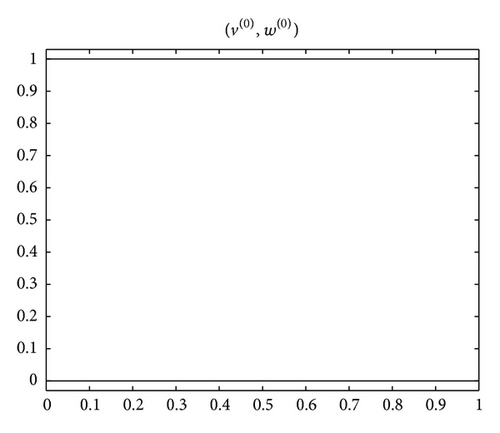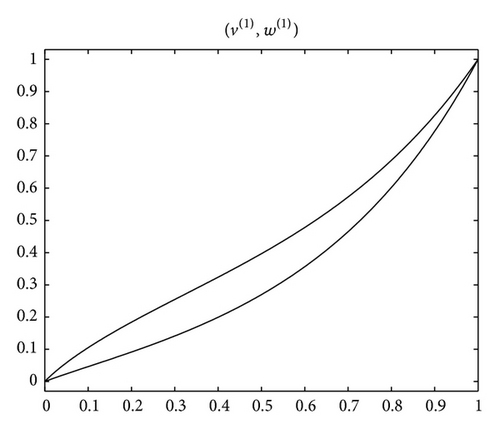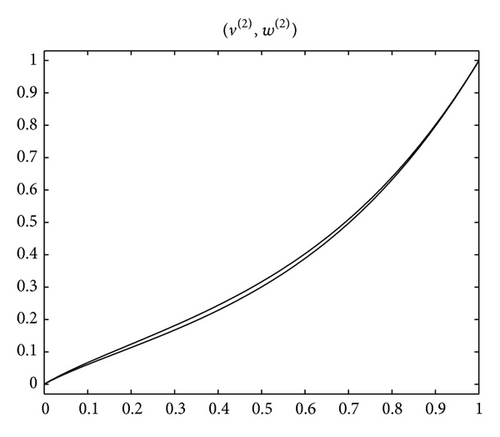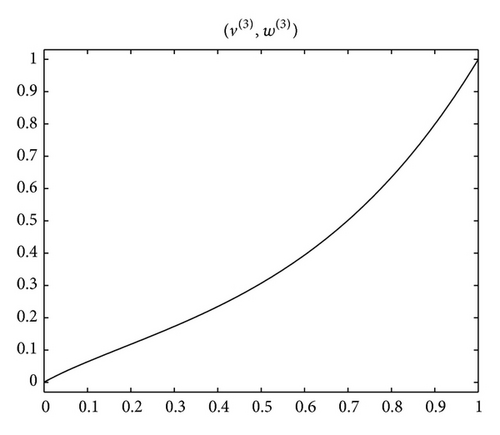Monotone Iterative Solutions for Nonlinear Boundary Value Problems of Fractional Differential Equation
Abstract
By means of the method of quasi-lower and quasi-upper solutions and monotone iterative technique, we consider the nonlinear boundary value problems with Caputo fractional derivative and introduce two well-defined monotone sequences of quasi-lower and quasi-upper solutions which converge uniformly to the actual solution of the problem, and then the existence results of the solution for the problems are established. A numerical iterative scheme is introduced to obtain an accurate approximate solution and to give one example to demonstrate the accuracy and efficiency of the new approach.
1. Introduction
It is well known that the differential equations with fractional order are generalization of ordinary differential equations to noninteger order, they occur more frequently in different research areas and engineering, such as physics, control of dynamical systems, chemistry and so forth. We also remark that several kinds of fractional derivatives were introduced to investigate the fractional differential equation, see, for example, [1, 2], and references therein.
The paper is organized as follows. Preliminaries are in Section 2. Then in Section 3, we construct the monotone sequences of quasi-lower and quasi-upper solutions and prove their uniform convergence to the unique solution of the problem. Finally, in Section 4, we establish the numerical approach employed to obtain accurate numerical solution, and give one example to demonstrate the accuracy and efficiency of the new approach.
2. Preliminaries
In this sections, we present the definition of a pair of quasi-lower and quasi-upper solutions and some lemmas which will be needed in the next section.
Definition 1. The functions v(0), w(0) ∈ C2([0,1], R) are called a pair of quasi-lower and quasi-upper solutions of the problem (1), if it satisfies
Lemma 2 (see [14].)Let p ∈ C2([0,1], R) and C > 0 is a constant. If p(t) satisfies the relations
Lemma 3 (see [14].)A function u(t) is a solution of the linear fractional BVP problems
Lemma 4. For all t ∈ [0,1], we have
Proof. The proof of this lemma is easy, so we omit it.
In the rest of the paper, for convenience sake, we define the set
-
(C1) v(0), w(0) is a pair of quasi-lower and quasi-upper solutions of the problem (1) and v(0)(t) ≤ w(0)(t), t ∈ [0,1].
-
(C2) The function f1(t, u) is increasing with respect to u, and f2 is decreasing with respect to u. And there exists a constant M ∈ (0, ΛΓ(μ)) such that
()
Lemma 5. Let (C1) and (C2) hold; then for any fixed η1, η2 ∈ [v(0), w(0)], the linear problems
Proof. Firstly, we prove that if is a solution of (17), then . From (C1), (C2) and if v(0) is a quasi-lower solution of the problem (1), then we have
Next, we show that (17) has a unique solution.
From Lemma 3, the problems (17) are equivalent to the following integral equation
Let
3. Monotone Sequences of Quasi-Lower and Quasi-Upper Solutions
In this sections we construct the monotone sequences of quasi-lower and quasi-upper solutions and prove their uniform convergence to the unique solution of the problem.
Theorem 6. Let (C1) and (C2) hold, and assume that (C3)v(k), w(k), k ≥ 1 is a pair of solutions of
- (i)
The sequence v(k), w(k) is a pair of quasi-lower and quasi-upper solutions of (1). Moreover,
() - (ii)
The sequence v(k), w(k) converges uniformly to v* and w*, respectively, with v(0) ≤ v* ≤ w* ≤ w(0). Moreover, v* and w* are a pair of minimal-maximal quasi-solutions of (1) in [v(0), w(0)].
- (iii)
Suppose further that there exist constants Li > 0(i = 0,1, 2) such that L1 + L2 < L0 ≤ M, and
() -
Then v* = w* is the actual solution of (1) in [v(0), w(0)].
Proof. (i) For any fixed η1, η2 ∈ [v(0), w(0)], consider the linear problems
Again, similar to the previous argument, we can show that
Now, let
To prove (i), we only need to show that v(k), w(k) are a pair of quasi-lower and quasi-upper solutions of (1). In fact, from (25) and condition (C2), we can obtain
(ii) Since the sequence v(k) is monotone nondecreasing and is bounded from above mention, the sequence w(k) is monotone nonincreasing and is bounded from below, therefore the pointwise limits exist and these limits are denoted by v* and w*. The sequence v(k), w(k) are sequences of continuous functions defined on the compact set [0,1], hence By Dini’s theorem [15], the convergence is uniform. This is
Moveover, from (25), we have
Now, we prove that v* and w* are a pair of minimal-maximal quasi-solutions of (1).
Let v, w ∈ [v(0), w(0)] be a pair of quasi-solutions of the problem (1), in the following, we show this using induction arguments. In fact, we have
(iii) Since v*(t) ≤ w*(t), t ∈ [0,1], it is sufficient to prove that v*(t) ≥ w*(t), t ∈ (0,1). In fact, from (40) and supposition (iii), we have (notice that v* ≤ w*)
4. Numerical Implementation
In this section, the numerical procedures are introduced to obtain an approximate solution of (1).
Remark 7. Applying the above numerical scheme, we can solve iteratively for v(k) and w(k) up to some large enough k = K. For a given accuracy ε, we take v(k) and w(k) as ε-accurate approximations of v* and w*, respectively. And we use
Example 8. Consider the fractional BVP
| k | 0 | 2 | 4 | 6 | 8 | 10 |
|---|---|---|---|---|---|---|
| E(k) | 1.000 | 1.117 × 10−2 | 1.302 × 10−4 | 1.259 × 10−6 | 1.048 × 10−8 | 7.632 × 10−11 |




Acknowledgment
This work was partially supported by NNSF of China (Grant no. 11171122).




